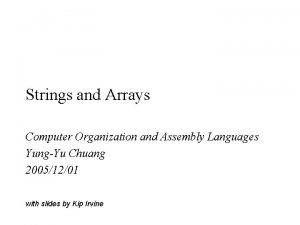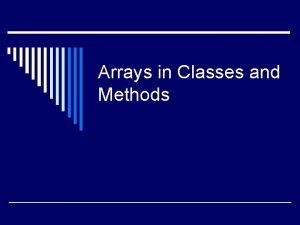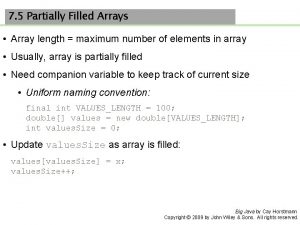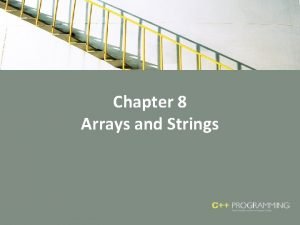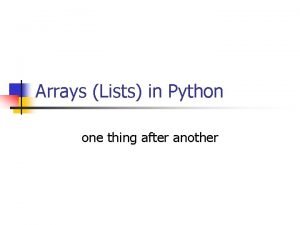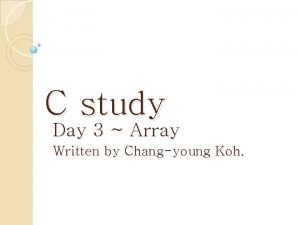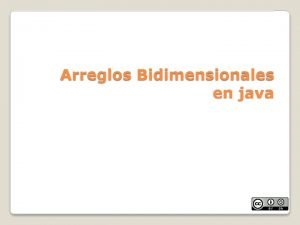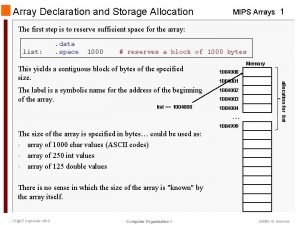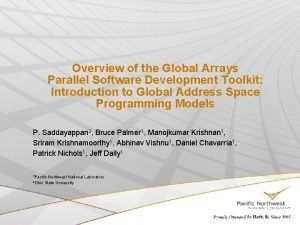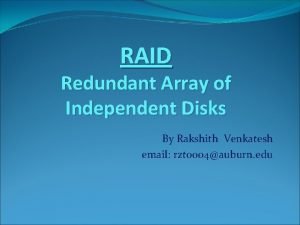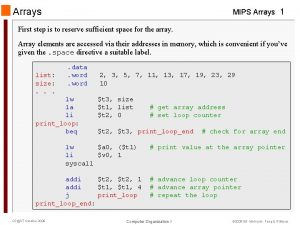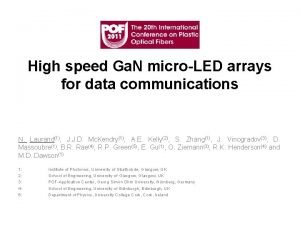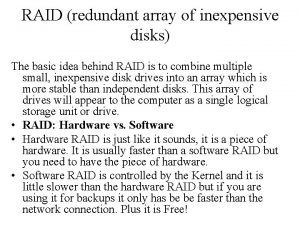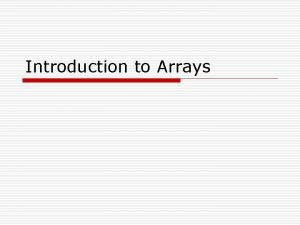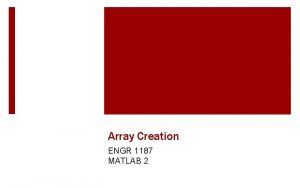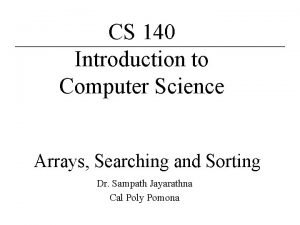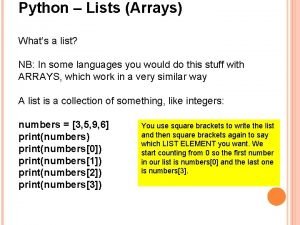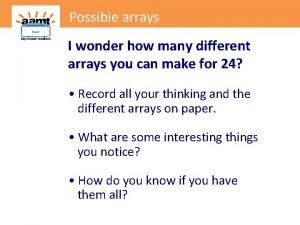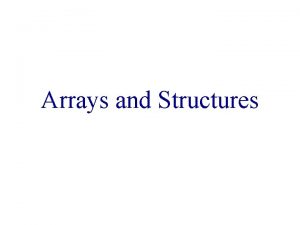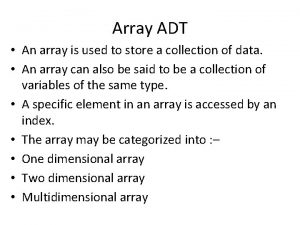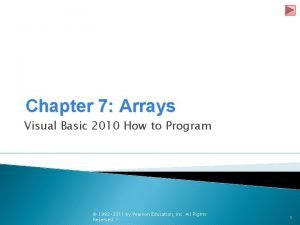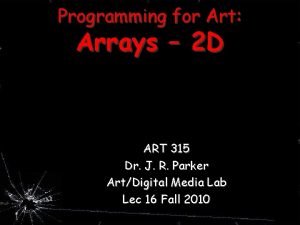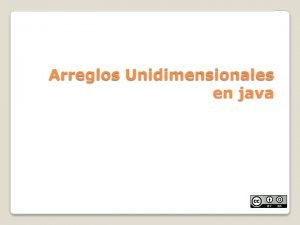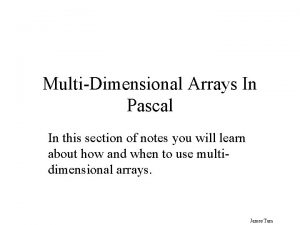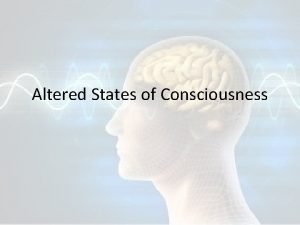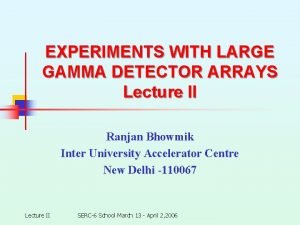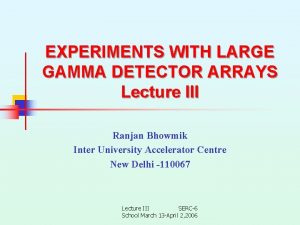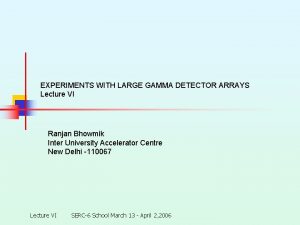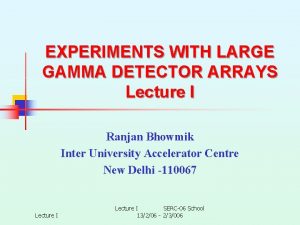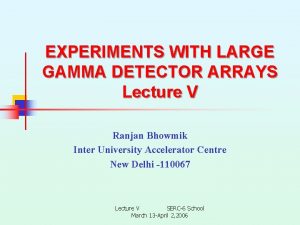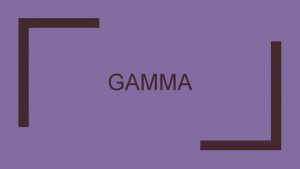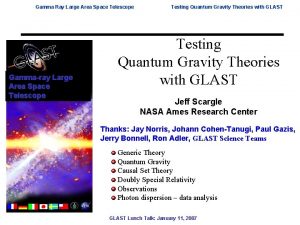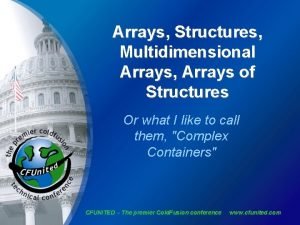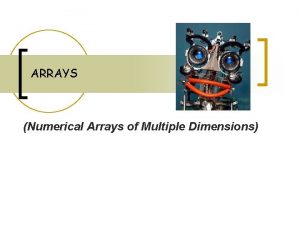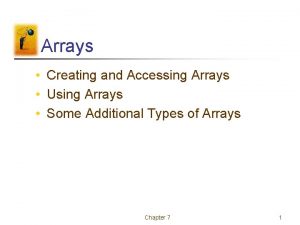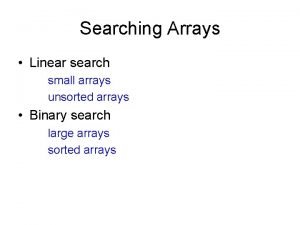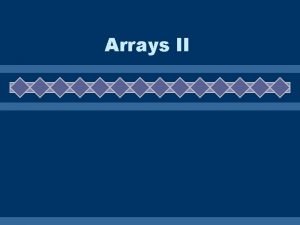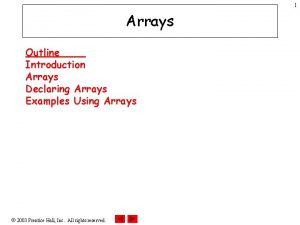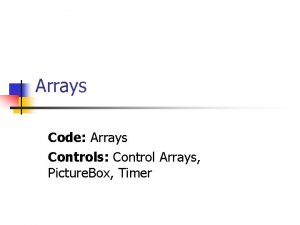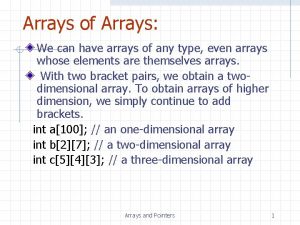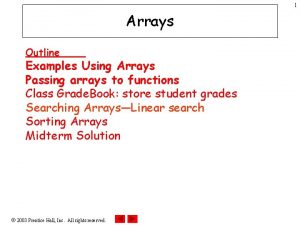EXPERIMENTS WITH LARGE GAMMA DETECTOR ARRAYS Lecture IV






































- Slides: 38

EXPERIMENTS WITH LARGE GAMMA DETECTOR ARRAYS Lecture IV Ranjan Bhowmik Inter University Accelerator Centre New Delhi -110067 Lecture IV SERC-6 School March 13 -April 2, 2006

ASSIGNMENT OF SPIN & PARITY Lecture IV SERC-6 School March 13 -April 2, 2006 2

General Properties of Electromagnetic Radiation Individual nuclear states have unique spin and parity. For decay from (Ei Ji Mi pi ) to (Ef Jf Mf pf), the electromagnetic radiation must satisfy the following relations: Energy Eg = Ei - Ef Multipolarity |Ji - Jf| L (Ji + Jf) M-state M = M i - Mf Parity p = pipf For time varying field, the vector potential A should satisfy the vector Helmholtz equation : The scalar Helmholtz equation has the following solution with states of good angular momentum L and parity (-1)L Lecture IV SERC-6 School March 13 -April 2, 2006 3

ELECTRIC & MAGNETIC TRANSITIONS The corresponding Vector solutions are : Parity (-1)L+1 Parity (-1)L At large distances (kr » 1), Electric and magnetic fields complimentary : E(r ; E) = H(r ; M) H(r ; E) = -E(r ; M) At short distances (kr « 1) |E(r ; E)| >> |H(r ; E)| |H(r ; M)| >> |E(r ; M)| This justifies the names 'Electric' and 'Magnetic' for the two types of fields. Electric field interacts with charges Electric multipole excitation Magnetic field interacts with currents (magnets) Magnetic multipole excitation Lecture IV SERC-6 School March 13 -April 2, 2006 4

ELECTRIC DIPOLE RADIATION n The classical radiation field from an oscillating dipole is given by P P ~ E H ~ sin 2 q r 2 n n which is maximum in a plane to dipole direction [ zero at 0 ] The electric field is in the plane containing the dipole. Quantum mechanically, this correspond to a dipole field with L=1 M=0 with linear polarization along q For an axially symmetric oscillating quadrupole field (Q 20) the radiation pattern P ~ E H ~ sin 2 qcos 2 q r 2 [ zero at 0 & 90 ] Quadrupole field with L=2 M=0 with linear polarization along q Lecture IV SERC-6 School March 13 -April 2, 2006 5

ANGULAR DISTRIBUTION OF MULTIPOLE RADIATION n n n Angular distribution Z(W) =| A(r, q, f) |2 is a function of q only For magnetic radiation, role of E & H are interchanged Similar angular distribution for electric and magnetic multipoles would differ in plane of polarization Adding all the M components incoherently would result in isotropic unpolarized radiation Lecture IV • Electric dipole radiation at 90 Polarization M = 0 || to axis M = 1 to axis • Electric Quadrupole radiation at 90 Polarization M = 1 || to axis M =2 to axis SERC-6 School March 13 -April 2, 2006 6

ELECTROMAGNETIC TRANSITION PROBABILITY The transition probability for the nucleus decaying from a state |Ji. Mi > to state |Jf. Mf > by an interaction R is given by Since we are not interested in the orientation of either the initial or the final nucleus, we sum over all Mf and average over all Mi. Angular distribution of the photon would involve contributions from different allowed values of L & M. Since k. R « 1, the transition probability Tfi decrease rapidly with L and the lowest allowed L is important. Lecture IV SERC-6 School March 13 -April 2, 2006 7

MULTIPOLARITY OF TRANSITION For a change in angular momentum DL = |Ji - Jf| the dominant multipolarities are : DJ Same Parity pi = pf Opposite parity pi pf 0 M 1, E 2 mixed radiation E 1 1 M 1, E 2 mixed radiation E 1 2 E 2 (M 2, E 3) M 1 & E 2 often have comparable strength Lecture IV SERC-6 School March 13 -April 2, 2006 8

RADIATION FROM ORIENTED NUCLEI § Random orientation of nuclei : radiation is isotropic as all Mi radioactive decay substates are to be added incoherently: § Nuclei oriented perpendicular to z-axis: fusion Populates large spins with Mi ~ 0 by heavy ion fusion Mi 0 nuclei decaying predominantly to Mf 0 For L=1 M = 0 q Emitted radiation maximum at q ~ 90 q Polarization || to z-axis for Electric transition For L=2 M = 0, 1 q Emitted radiation minimum at q ~ 90 q Polarization || to z-axis for Electric transition § Nuclei oriented along z-axis : M=L Lecture IV L=DJ for stretched transition polarized nuclei Angular distribution opposite; polarization reversed in sign SERC-6 School March 13 -April 2, 2006 9

ALIGNMENT IN NUCLEAR REACTION n n In fusion reaction between even-even nuclei, compound nucleus is populated with high spin at M=0 state. Successive particle emission would broaden the M-distribution. Since the g-decay along the cascade is mostly stretched in nature (DJ =L) the Mdistribution of the decaying state Ji would be centered around M=0 If the spin distribution is symmetric i. e. P( -M) = P(M) NUCLEAR ALIGNMENT Asymmetric spin distribution P(M) > P(-M) leads to NUCLEAR POLARIZATION Gaussian parameterization for oriented nuclei: P(Mi) ~ exp(-Mi 2/s 2)/Si exp(-Mi 2/s 2) Lecture IV with s/Ji ~ 0. 3 SERC-6 School March 13 -April 2, 2006 10

ANGULAR DISTRIBUTION IN FUSION Angular distribution of g-transitions can be measured by moving the detector to a different q and normalising the counting rate w. r. t. a fixed detector Shows pronounced anisotropy : W(q) = 1 +a 2 P 2(cosq) +a 4 P 4(cosq) n Symmetric about 90 W(q) = W(p - q) n n Only even orders allowed with Nmax 2 L 'Beam in' & 'Beam out' directions equivalent Nucl. Phys. A 95(1967)357 Lecture IV SERC-6 School March 13 -April 2, 2006 11

Theoretical angular Distribution The theoretical angular distribution from a state Ji to a state Jf by multipole radiation of order L, L' can be written as : where r. K Statistical Tensor describing initial state population. Only even K allowed for symmetric M distribution Depends on the population width s Normalize to transitions with known multipolarity AK Geometrical factor depending on 3 j, 6 j, 9 j symbols Sensitive to L-change in the high spin limit AK(Ji. LL'Jf) ~ AK(DJ, L) Lecture IV SERC-6 School March 13 -April 2, 2006 12

ANUGULAR DISTRIBUTION FOR PURE MULTIPOLES Angular distribution coeffs for pure multipoles in high spin limit for ideal initial M-distribution P(M) =1 for M=0 or ½ Lecture IV DJ L a 2 a 4 0 1 0. 500 0 0 2 -0. 357 -. 542 1 1 -0. 250 0 1 2 -0. 179 0. 429 2 2 0. 357 -0. 107 SERC-6 School March 13 -April 2, 2006 13

SYSTEMATICS OF L=2 TRANSITIONS n n Angular distributions for DJ =2 very similar with a minimum at 90 For most transitions a 2 = +0. 30 0. 09 a 4 = -0. 09 0. 05 2 0 transitions show large deviation due to external perturbation Large anisotropy consistent with a narrow M-distribution s ~ 0. 3 J Lecture IV PRL 16(1966)1205 SERC-6 School March 13 -April 2, 2006 14

SYSTEMATICS OF DIPOLE TRANSITIONS n n Dipole transitions have a maximum at 90 a 2 -ve -a 2 ~ 0. 4 - 0. 6 If there is no change in parity, M 1 can be mixed with E 2 transitions Angular distribution sensitive to the mixing ratio As the transitions are weak L=1 mostly seen in coincidence measurements Lecture IV E 2 PRL 16(1966)1205 M 1, E 2 SERC-6 School March 13 -April 2, 2006 15

MIXING RATIO If for transition between states Ji Jf two multipolarities L, L' are allowed, is the ratio of the reduced nuclear matrix elements a real number - Sign of depends on the relative phase of the nuclear matrix elements Angular distribution To extract from measured W(q), r. K must be estimated from a model of P(M) or extracted from pure E 2 angular distribution Lecture IV SERC-6 School March 13 -April 2, 2006 16

DETERMINATION OF MIXING RATIO n n n Angular distribution of g-rays sensitive to DJ and mixing ratio Solid curve : pure L=2 Dotted curve : pure L=1 Dashed & dot-dashed curve: mixed transition = -1 & +1 Large interference effects for DJ =1 Knowledge of both a 2 & a 4 important to identify the spin change DJ Lecture IV SERC-6 School March 13 -April 2, 2006 17

ANGULAR CORRELATION n n Weak transitions in a g-cascade can only be identified in g-g coincidence measurements Angular correlation W(q 1, q 2, f) can be calculated theoretically if M -state population is known with sum over all variables K, K 1, K 2, q 1, q 2 For decay from symmetric M-distribution all K are even Lecture IV SERC-6 School March 13 -April 2, 2006 18

ANGULAR CORRELATION As a special case, we consider radioactive decay of a cascade of gtransitions. Because of the random orientation of the 4+ state populated by b -decay, all r. K zero. By summing over all other indices the angular correlation is obtained as : where AK(1), AK(2) are the coefficients characterising the two transitions and q is the angle between the detectors. Lecture IV SERC-6 School March 13 -April 2, 2006 19

ANGLAR CORRELATION : SYMMETRY PROPERTIES Symmetric M distribution, 'beam in' & 'beam out' equivalent W(q 1, q 2, f) = W( p - q 1, p - q 2, f) Additional symmetries involving f p - f and f p +f NIMA 313(1992)421 n Integration over out-of-plane angle f product of angular distributions NPA 563(1993)301 § Integration over angle of one detector Integration over all detectors gives the angular distribution Angular distribution from angular correlations using large array Lecture IV SERC-6 School March 13 -April 2, 2006 20

Similarity between angular distribution & angular correlation Lecture IV SERC-6 School March 13 -April 2, 2006 21

Anisotropy in angular distribution n n 'Gated angular distribution' extracted from the angular correlation W(q 1, q 2) by summing over all q 2 Anisotropy defined as PRC 53(1996)2682 E 2/M 1 where q. A ~ 0 or 180 q. B ~ 90 n Sensitive to DJ & n Gating with unknown L possible Lecture IV E 1 M 1/E 2 Mixing Angle Three possible solutions !! need linear polarization data SERC-6 School March 13 -April 2, 2006 22

Directional Correlation from Oriented Nuclei Useful information about DJ can be obtained by measuring coincidences between two detectors, one near 90 and the other near 0 with respect to beam direction If the detectors are sensitive to both radiations g 1 & g 2 we can distinguish between (i) g 1 in detector 1 g 2 in detector 2 (ii) g 2 in detector 1 g 1 in detector 2 DCO = W(g 1, q 1; g 2, q 2)/W(g 1, q 2; g 2, q 1) Lecture IV SERC-6 School March 13 -April 2, 2006 23

DCO Ratio n n n Ignoring f dependence we get DCO ratio ~ [W(g 1; q 1)*W(g 2; q 2)] / [W(g 1; q 2)*W(g 2; q 1)] = [W(g 1; q 1)/ W(g 1; q 2)] * [W(g 2; q 2)/W(g 2; q 1)] If both radiations g 1 and g 2 have the same multipolarity, they have similar angular distribution and DCO ratio =1 If they have different multipolarity i. e. L=1 for g 1 and L=2 for g 2 both terms greater than 1 and DCO ~ 2 Exchange of angles or exchange of gating multipolarity would invert the ratio Generalization valid only for Stretched transitions ! Some papers have inverted definition i. e. NIMA 275(1989)333 Lecture IV SERC-6 School March 13 -April 2, 2006 24

EXPERIMENTAL DCO RATIO n n n Gate on E 2 transition 607 ke. V transition E 2 484, 506, 516, 568, 617 ke. V transitions dipole 93 Tc E 2 gate PRC 47(1993)87 Lecture IV SERC-6 School March 13 -April 2, 2006 25

DCO Ratio : advantages n n n n Can be used for weak transitions More sensitive to angular distribution i. e. W(q)2 Ideal for small arrays with limited number of angle combinations Not overly sensitive to choice of angles 75 < q 1 < 105 q 2 < 30 or q 2 >150 DCO similar for both M 1 & E 2 transitions if DJ =1 Large interference effect for mixed transitions gate on L=2 q 1=90 f =0 DCO ambiguity for DJ=0, 1 Lecture IV SERC-6 School March 13 -April 2, 2006 26

Sensitivity of DCO Ratio to mixing parameter EPJA 17(2003)153 Two solutions, need polarization data !! Lecture IV SERC-6 School March 13 -April 2, 2006 27

POLARIZATION MEASUREMENTS n n n Angular distribution for both E 1 and M 1 similar; maximum at 90 Can be distinguished by polarization measurement Stretched E 1 transition has polarization vector in-plane stretched M 1 transition has polarization vector perpendicular to plane Maximum polarization at q = 90 Can be studied in (i) singles (ii) in coincidence with another detector (PDCO) (iii) measuring polarization of both detectors (PPCO) Lecture IV RMP 31(1959)711 NIM 163(1979)377 NIMA 362(1995)556 NIMA 378(1996)516 NIMA 430(1999)260 SERC-6 School March 13 -April 2, 2006 28

POLARIZATION FORMALISM Polarization in a nuclear reaction : where J 0 , J 90 are the average intensities of the Electric vector in plane with the beam direction & perp. to the plane. Angular distribution : Polarization : Maximum at 90 with a value for pure E 1, M 1 or E 2: P= +1 (E 1, E 2) ; -1 (M 1) Lecture IV SERC-6 School March 13 -April 2, 2006 29

Measurement of Polarization n n Compton Scattering is sensitive to the polarization direction Vertically polarized photons would be preferentially scattered in the horizontal plane Klein-Nishina formula Maximum sensitivity at q ~ 90 Lecture IV SERC-6 School March 13 -April 2, 2006 30

Detection of Compton-scattered radiation n n Two Ge detectors : one as scatterer and other as detector of scattered radiation Need large efficiency for coincident detection Identified as Eg = E 1 + E 2 Experimental Asymmetry a(Eg) corrects for any instrumental effect between horizontal & vertical plane Lecture IV SERC-6 School March 13 -April 2, 2006 31

Lecture IV CLOVER GAMMASPHERE Different Designs of Polarimeter SERC-6 School March 13 -April 2, 2006 32

CLOVER as a Polarimeter n n Polarization sensitivity Q = A/P where P is polarization of the incident radiation Large polarization sensitivity Q ~ 13% at 1 Me. V Large Compton detection efficiency ~ 40% at 1 Me. V Measurement in singles or in coincidence Lecture IV NIMA 362(1995)556 SERC-6 School March 13 -April 2, 2006 33

Measurement of Polarization Electric Magnetic Lecture IV SERC-6 School March 13 -April 2, 2006 34

Polarization Measurement in 163 Lu PRL 86(2001)5866 NPA 703(2002)3 Lecture IV SERC-6 School March 13 -April 2, 2006 35

Polarization measurement in 163 Lu Confirmation of the wobbling mode in 163 Lu through combined angular distribution and linear polarization measurement Lecture IV SERC-6 School March 13 -April 2, 2006 36

Polarization-Direction Correlation PDCO Polarization-Polarization Correlation PPCO With the availability of a large array of Clover detectors, we can measure the polarization of one or both g-rays in coincidence. This results in additional information in the form of PDCO (where one polarization is measured) or PPCO where both polarizations are measured. Combined with DCO this provides a powerful tool for spin assignment. NIMA 430(1999)260 Lecture IV SERC-6 School March 13 -April 2, 2006 I 4+ 2+ 37

Lecture IV SERC-6 School March 13 -April 2, 2006 38
 01:640:244 lecture notes - lecture 15: plat, idah, farad
01:640:244 lecture notes - lecture 15: plat, idah, farad Strings in assembly language
Strings in assembly language Facts about arrays
Facts about arrays Java partially filled array
Java partially filled array Parallel arrays
Parallel arrays Python find index of max
Python find index of max Day 3: arrays
Day 3: arrays Arreglos bidimensionales java
Arreglos bidimensionales java Disadvantages of arrays
Disadvantages of arrays Mips dynamic array
Mips dynamic array Array of arrays c++
Array of arrays c++ Global arrays in c
Global arrays in c Redundancy array of independent disk
Redundancy array of independent disk Why do we need arrays?
Why do we need arrays? Advantages and disadvantages of arrays
Advantages and disadvantages of arrays Arrays mips
Arrays mips Microled arrays
Microled arrays Raid redundant array of independent disks
Raid redundant array of independent disks Java array operations
Java array operations Creating arrays matlab
Creating arrays matlab Searching and sorting arrays in c++
Searching and sorting arrays in c++ Computer science arrays
Computer science arrays Python list of arrays
Python list of arrays Dynamic arrays and amortized analysis
Dynamic arrays and amortized analysis I wonder is it possible
I wonder is it possible Polynomial representation using arrays
Polynomial representation using arrays Are vectors dynamic arrays
Are vectors dynamic arrays Veteork
Veteork Arrays as adt
Arrays as adt Arrays visual basic
Arrays visual basic Arrays
Arrays Arreglos unidimensionales en java
Arreglos unidimensionales en java Small basic arrays
Small basic arrays Pascal multidimensional array
Pascal multidimensional array Parallel arrays
Parallel arrays Mendel's three laws
Mendel's three laws Dream experiments
Dream experiments Examples of binomial experiments
Examples of binomial experiments Science risk assessment primary school
Science risk assessment primary school

